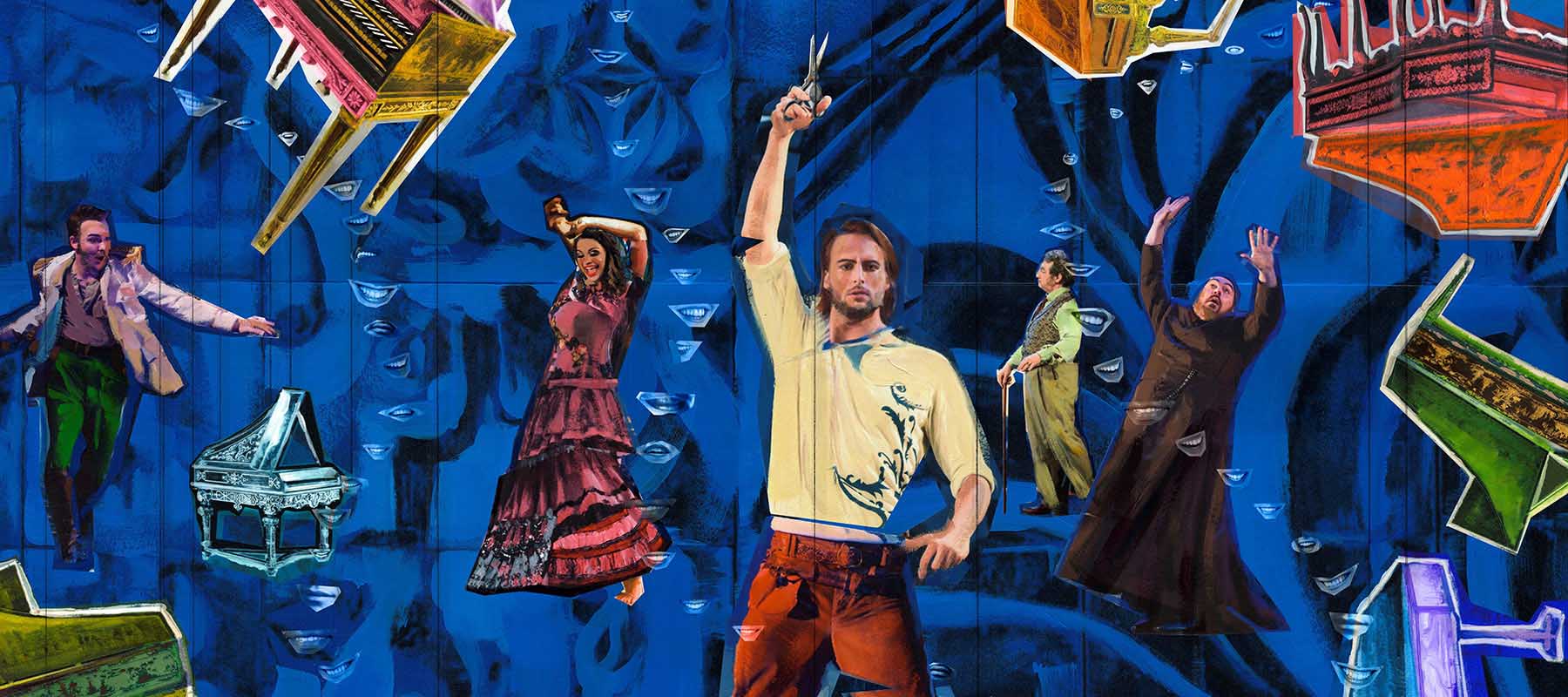
Festival 2019: the music you didn’t know you knew
This Festival season is jam packed full of well known numbers, with many famous beyond the opera world.
From Bugs Bunny to Robin Williams in Mrs Doubtfire, we take a look through the operas and pick out how you may know the music you didn’t think you knew.
La damnation de Faust by Berlioz

Context: The piece appears fairly early in the opera; Faust remarks on an army of troops passing by in the distance, not understanding why they have such pride and glory while he remains indifferent to everything. The March is based on an old traditional folk tune from Hungary, from an unknown composer. Berlioz was so inspired by the piece that it is the cause of his setting the opera in Austria, rather than Germany as in Goethe’s original.
How famous is it?: It is now perhaps the most famous and certainly most recognisable excerpt from the opera, and is often performed alone as an orchestral encore, or with two of the other instrumental passages from the opera as Three Orchestral Pieces from La damnation de Faust. The original has also been arranged by Liszt in his Hungarian Rhapsody No.15, and also by pianist Vladimir Horowitz.
Il barbiere di Siviglia by Rossini

Context: The overture was actually recycled by Rossini from two of his earlier operas, Aureliano in Palmira and Elisabetta, regina d’Inghilterra. As such, it doesn’t actually contain any of the thematic material from Barbiere, although it has become synonymous with the opera and arguably Rossini’s most famous musical excerpt.
How famous is it: The overture is one of the most instantly recognisable ‘jingles’ from the operatic repertoire, rivalling the most famous tunes from Carmen or Nozze di Figaro. It has been used extensively in popular culture and everyone has almost certainly heard it in a non-operatic context. Looney Tunes made an iconic Bugs Bunny version in 1949, called The Rabbit of Seville.
Many adverts have used the overture: Armani Code Ice, Honey Nut Cheerios, the list goes on!
The Simpsons also made an episode titled The homer of Seville referencing the opera whilst comedy-music duo Kit and the Widow have actually done a parody of the overture with lyrics that gently rib Glyndebourne!
Context: A highly entertaining and vocally demanding introduction to the barber Figaro, as he describes his work and his knowledge of the town. Not only is it musically demanding, but the tongue-twister Italian lyrics (lots of -issimo’s) make the aria a huge crowd pleaser and a great opportunity for a baritone to demonstrate his vocal prowess.
How famous is it?: This is by far the most famous and revered aria in Barbiere. The ‘Figaro, Figaro, Figaro….’ repetitions are particularly iconic, with this excerpt popping its head in a massive range of non-operatic contexts. A classic example is in the 1993 film Mrs Doubtfire which opens with Robin Williams providing a voiceover to a cartoon bird singing the song.
The excerpt has been constantly chopped and changed in adverts with the Fiat Strada advert and its famous ‘built by robots’ tagline using the music; and The Fifa16 ad hilariously changing the words to ‘beautiful football, look at this football.’
And for those Tom and Jerry fans out there, they also did an episode where the two of them sing the song.
Cendrillon (Cinderella) by Massenet

Context: It is a magical scene in Act III when The Fairy Godmother conjures spirits and a magical power, bringing Cendrillon and the Prince together at a magic oak tree for a mystical ceremony of love. They exchange their vows, embrace, then fall asleep by a stream.
How famous is it: Massenet’s exquisite, beautiful writing is evident in passages like the love duet in Act III. It echoes one of his very famous pieces Meditation, an entr’acte from his opera Thaïs, which people may well have heard without knowing that it comes from opera. It’s an instrumental passage between scenes in Act II, written for violin and orchestra, and is known as one of the most iconic violin encores of all time.
Also for lovers of Disney, the Charles Perrault written fairy tale of Cendrillon was made popular by Walt Disney’s 1950’s animated film Cinderella. In the film, ‘So this is love’ is equivalent to the love duet in the opera.
Rusalka by Dvořák

Context: Song to the Moon is protagonist Rusalka’s lament to the moon, asking it to tell the Prince of her love for him. It is some of the most exquisite music in the opera, and known in its own right as a stand-alone aria. It has also been adapted for other instruments, most notably the violin.
How famous is it: Rusalka is a lyric fairy tale whose whole plot people may not actually realise they already know, again depending on their Disney film knowledge. The Little Mermaid is practically the same story (although with a cheerier ending), and Song to the Moon is the operatic original to Ariel’s Part of your world.
The song has been used in countless films, most notably Driving Miss Daisy in 1989, The Hunter in 2011 and Departure in 2015. Anyone who saw Bel Canto last year may also have noted its use. Renée Fleming, for whom Rusalka was one of her most celebrated roles, recorded the Song to the Moon in this film for Julianne Moore to lip-sync.
Die Zauberflöte by Mozart

Context: Mozart wrote the aria for his sister-in-law Josepha Hofer, who played the first Queen of the Night, and was known for her vocal dexterity and incredible upper register, hence the iconic top Fs and two octave range. The impressive skill required to pull this aria off, and the delicate musicality required for Mozart, makes this aria a huge crowd pleaser. In addition, the dramatic and menacing music reflecting the Queen’s fit of rage as she demands that her daughter Pamina assassinates her rival creates an incredible energy while driving the plot forward.
How famous is it: In addition to the films that have been made of the opera itself, and also the famous cello variations, the opera has many well known arias that regularly make an appearance on the radio. The Queen of the Night aria, is one of the most celebrated extracts of Mozart’s operatic work. It has again been extensively reworked into pop culture; unsurprisingly it makes an appearance in the 1984 film Amadeus, also more recently in Eat, Pray, Love and is currently being used in a much more toned down performance as the music to the 2019 Volvo XC90 range. The aria was also a favourite of the famously incompetent singer Florence Foster Jenkins and parodied by Meryl Streep in the film about her.
Rinaldo by Handel

Context: This sarabande is perhaps the most well known musical moment in Rinaldo, as the protagonist weeps over his fate. The music originally comes from a sarabande in Rinaldo’s Almira.
How famous is it: The aria has been used frequently in films, such as Farinelli in 1994, L.I.E. in 2001, Antichrist in 2009 and Nymphomaniac in 2013. It is also likely to be known for its use in the Harrods Christmas sale advert!
Image credits: Festival 2019 painted production collages by Shadric Toop












